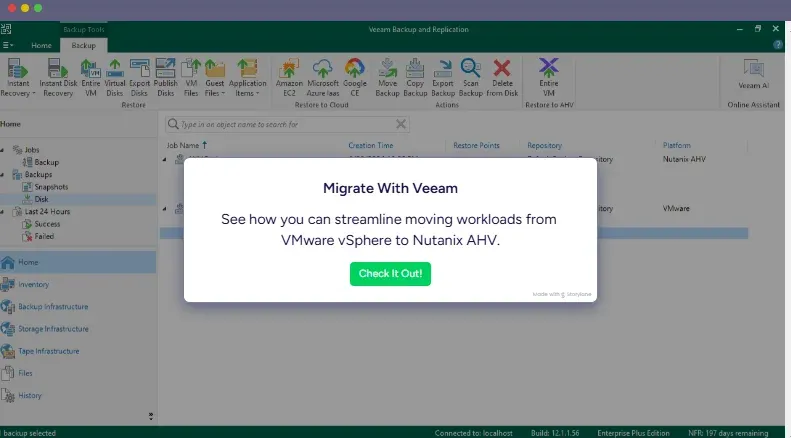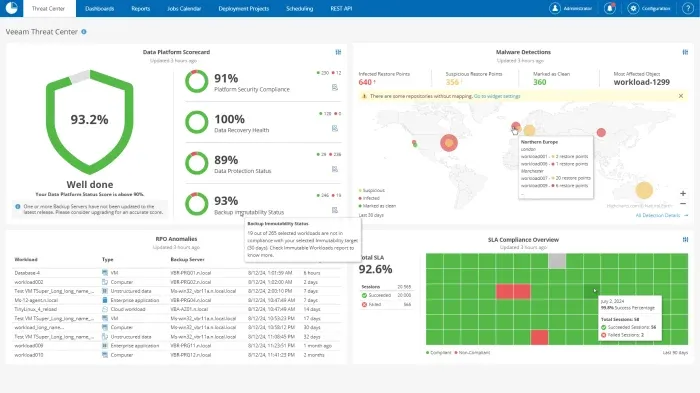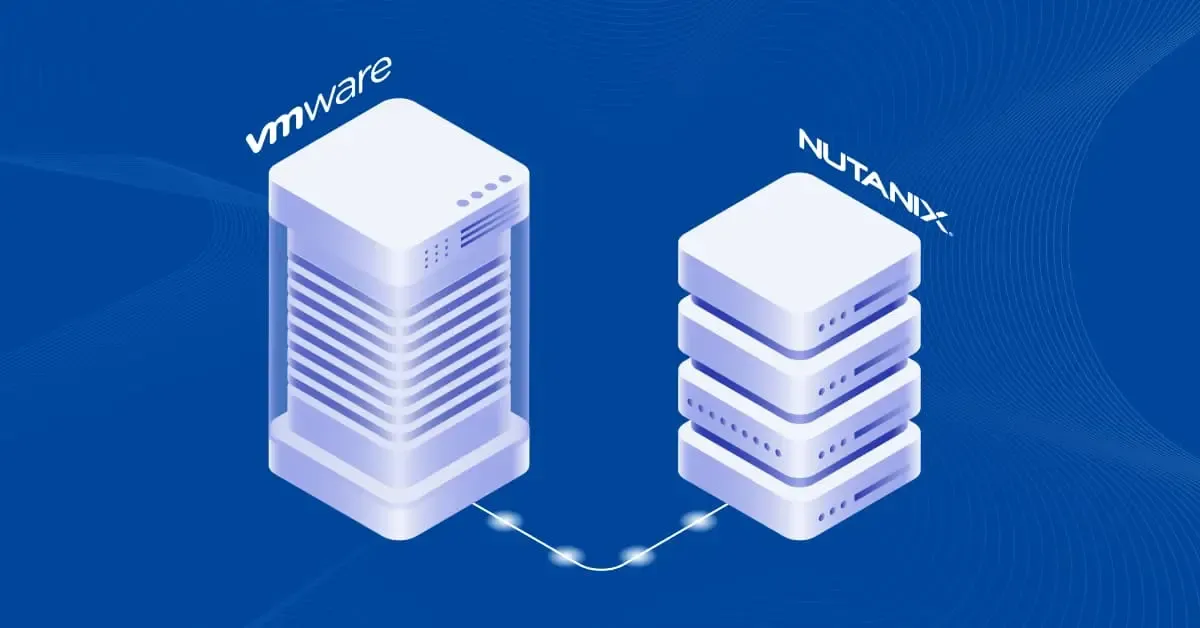Transitioning from VMware ESXi to Nutanix AHV requires careful planning and execution to ensure a seamless migration. This guide breaks down the process into clear steps, helping you migrate your virtual machines (VMs) efficiently while minimizing downtime.
Step 1: Assess Your Existing VMware ESXi Environment
Before starting the migration, a thorough assessment of your current infrastructure is essential to ensure a smooth transition. Key areas to evaluate include:
-
VM Inventory: Identify all VMs, document their configurations (CPU, memory, storage), and note dependencies on other systems. Tools like Veeam ONE or RV Tools can simplify this process by providing an in-depth overview of your virtual infrastructure.
-
Network Mapping: Review your network setup, including VLANs, subnets, IP schemes, firewalls, and application connectivity. Understanding this will be crucial when configuring networking in Nutanix AHV.
-
Storage Analysis: Assess the storage capacity and performance needs of your VMs to ensure your Nutanix cluster has adequate resources for the migration.
Downtime Tolerance: Determine how much downtime your applications can afford, as this will influence which migration method best suits your needs.
Step 2: Choose the Right Migration Method
There are multiple ways to migrate VMs from vSphere to Nutanix AHV, each with its own benefits:
-
Nutanix Move (Recommended): Nutanix Move is a native tool designed to simplify migration with minimal disruption. It automates VM conversion, replicates data in real time, and ensures seamless network mapping, reducing manual intervention.
-
Manual Migration: This method involves exporting VMs from ESXi as OVF/OVA files and importing them into AHV. While this offers greater control, it requires more time and technical expertise.
-
Backup-Based Migration: If using Veeam, you can restore VMs from backups directly into AHV, leveraging Instant VM Recovery to reduce downtime and maintain data resilience.

Step 3: Executing the Migration
No matter which migration method you choose, the overall workflow typically follows these key steps to ensure a smooth and successful transition from VMware ESXi to Nutanix AHV.
1. Preparing your AHV environment: Ensure that your Nutanix cluster has sufficient capacity to accommodate incoming VMs. Then, configure networking and storage settings in AHV to align with your ESXi environment.
2. Converting VM formats (if necessary): If your ESXi VMs use a disk format that’s not directly supported by AHV, you may need to convert them. Tools like the “qemu-img” utility can facilitate this conversion process.
3. Transferring VM data: Utilize your chosen migration method (e.g., Nutanix Move, manual export/import, or your Veeam backups) to transfer your VM data from ESXi to AHV. This is a critical phase, and it’s essential to monitor the transfer closely to ensure data integrity.
4. Validating VM functionality: After migration, power on VMs within the AHV environment and thoroughly test their functionality. Also, ensure that applications, services, and network connectivity are operating as expected.
5. Optimizing for AHV: Once your VMs are running smoothly, take advantage of AHV’s specific features and capabilities to optimize performance. This may involve:
Adjusting storage policies: Tailor storage policies to match the workloads for performance improvements.
- Enabling deduplication and compression: These features help reduce the storage footprint and improve efficiency, especially for large datasets.
- Fine-tuning performance settings: Adjust CPU and memory resources dynamically based on workload demand.
Step 4: Ensuring Reliable Backups
To safeguard your data from unexpected incidents during and after migration, it is essential to establish a consistent backup strategy and implement strong data protection measures.
7. Automated Backup Scheduling
Set up automated backup routines to regularly capture the latest state of your virtual machines (VMs). This ensures that up-to-date copies of your VMs are readily available for quick recovery in case of data loss or system failures.
6. Backup Integrity Verification
Periodically validate backup integrity to confirm that the data is both recoverable and uncorrupted. While some environments may lack built-in automated verification tools, manual integrity checks can still be performed to ensure reliable data restoration.
5. Enhancing Data Security
Protect your backups by encrypting data both in transit and at rest to prevent unauthorized access. Conduct regular security audits and compliance assessments to maintain a secure backup environment and mitigate potential vulnerabilities.
4. Disaster Recovery (DR) Strategy
Develop a comprehensive disaster recovery (DR) plan that incorporates regular testing of backup and recovery procedures. This ensures that your organization is well-prepared to rapidly restore operations in the event of data loss, system failure, or cyber threats.
Step 5: Key Post-Migration Considerations
Even after successfully migrating your virtual machines (VMs) to Nutanix AHV, ongoing monitoring and optimization are essential to ensure long-term performance and stability. Addressing potential issues proactively will help maintain a seamless user experience.
1. Continuous Monitoring & Proactive Alerts
Deploy Veeam ONE or Nutanix-integrated monitoring tools to keep track of VM health and performance. Set up automated alerts for key metrics such as CPU usage, memory consumption, and network performance. Proactive monitoring helps identify and resolve issues before they affect end users.
2. Performance Optimization
Fine-tune your VMs to ensure they operate efficiently within the AHV environment. This includes adjusting resource allocations, optimizing storage settings, and refining network configurations. Leveraging AHV’s built-in optimization tools can enhance overall performance and responsiveness.
3. Capacity Planning for Future Growth
Regularly assess resource utilization within your AHV cluster. As your workloads and business needs expand, proactive capacity planning ensures that your infrastructure remains scalable and performs efficiently without bottlenecks.
4. Security & Compliance Audits
Conduct periodic security assessments to maintain a secure and resilient AHV environment. Key security measures include:
- Reviewing access controls to ensure only authorized users have permissions.
- Applying security patches and updates to safeguard against vulnerabilities.
- Monitoring for anomalous activity that could indicate potential security threats.
Additionally, Veeam’s advanced security features, such as immutability, protect backups from ransomware attacks, ensuring critical data cannot be altered or deleted. Implementing multi-factor authentication (MFA) and role-based access control (RBAC) further strengthens security.
5. Keeping Software & Firmware Up to Date
Regular software updates are crucial for performance enhancements, security improvements, and new feature availability. Schedule updates during maintenance windows to minimize downtime and disruptions while keeping the AHV environment fully optimized.
6. Gathering User Feedback for Continuous Improvement
Encourage end users to provide feedback on system performance and functionality. This helps identify potential areas for enhancement, troubleshooting, and optimization to ensure that the AHV environment aligns with operational needs.

How Veeam Enhances Your Migration Journey
When transitioning from VMware ESXi to Nutanix AHV, Veeam provides a secure, reliable, and seamless approach to data protection. Our solutions ensure that your critical workloads remain safeguarded throughout the migration process, offering business continuity without bias toward any specific platform.
Dependable Backup & Rapid Recovery
Veeam serves as a safety net throughout your migration. By creating comprehensive backups before initiating the transition, you can mitigate risks and recover quickly in case of unexpected disruptions. Should any issues arise, our fast recovery options allow you to restore data and services immediately, minimizing downtime and ensuring uninterrupted business operations.
Seamless Data Replication
Our real-time replication technology keeps your data synchronized across both VMware and Nutanix environments. This ensures that your information is always up to date, eliminating inconsistencies and preventing post-migration discrepancies that could impact performance.
User-Friendly Backup Management
Veeam’s intuitive interface simplifies backup and replication tasks, making it easy to manage your data throughout the migration. Our streamlined integration means you can focus on core business objectives rather than getting bogged down in complex technical processes.
Advanced Data Security Measures
Keeping your data secure is our top priority. Veeam employs strong encryption standards to protect backups and replicas from unauthorized access both during and after migration. This ensures that your sensitive data remains confidential and uncompromised at all times.
Effortless Compliance & Reporting
Meeting regulatory requirements is crucial, and Veeam simplifies compliance by offering detailed reporting and audit-ready documentation. These reports provide complete transparency into your data’s movement and protection status, ensuring accountability and adherence to industry regulations.
A Trusted Partner for Your Migration
Choosing Veeam means more than just selecting a backup solution—it means gaining a reliable partner committed to securing your data during critical IT transitions. While your infrastructure may evolve, Veeam ensures that your data remains protected, accessible, and resilient every step of the way.
Don’t let hypervisor migration overwhelm you! With Veeam Data Platform, you can streamline the transition by leveraging cross-platform backup and recovery, ensuring that your workloads move to the new hypervisor within minutes while maintaining strong security and data protection throughout the process.
Whether your organization is small or enterprise-scale, this transition marks a major transformation—but you don’t have to do it alone. Learn more about how Veeam can help you optimize and secure your workload migration with ease.







